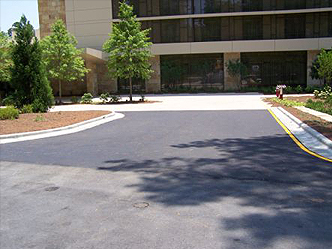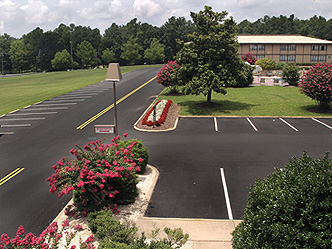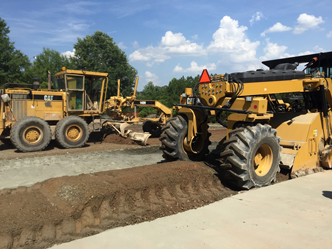Asphalt Repair
RDU Paving Provides the Following Asphalt Repairs:
 ASPHALT REPAIR: Asphalt Repair including patching and pothole repair is often a cost-effective appropriate solution to isolate pavement areas that have failed. Areas that have potholes or are severely alligatored are obvious pavement failures that require cutting, debris removal, and replacement with full-depth asphalt. Asphalt Patching provides strength to the existing pavement structure by replacing the failed pavement with a solid base. Depending on the size of the failing pavement area, we may be able to easily fill or fix your pothole, or we may have to repair a larger area of damaged pavement for the best results. Our estimators evaluate pavement defects on a case-by-case basis by and match them to the most appropriate solution.
ASPHALT REPAIR: Asphalt Repair including patching and pothole repair is often a cost-effective appropriate solution to isolate pavement areas that have failed. Areas that have potholes or are severely alligatored are obvious pavement failures that require cutting, debris removal, and replacement with full-depth asphalt. Asphalt Patching provides strength to the existing pavement structure by replacing the failed pavement with a solid base. Depending on the size of the failing pavement area, we may be able to easily fill or fix your pothole, or we may have to repair a larger area of damaged pavement for the best results. Our estimators evaluate pavement defects on a case-by-case basis by and match them to the most appropriate solution.
Be cautious of contractors that recommend simply overlaying the damaged areas with new asphalt. In a short time period, the previous cracked areas will show up in the new asphalt as reflective cracking. If your budget is a concern, we will work with you to provide a plan that will result in the best value and long-term solution for you. Combining patching with Sealcoating, PDC, or Rejuvenator and then planning for an overlay in a few years is a much better solution than simply overlaying the existing damaged asphalt.
 ASPHALT RESURFACING: As asphalt ages, it begins to gray and develop hairline cracks, alligator-like areas, or potholes. If this is too extensive, asphalt patching alone may not be a practical solution. Some patching may be necessary along with bituminous surface treatment (BST) to stabilize the area. Finally, an asphalt overlay can be placed. The final result is a smooth, black surface. We combine the optimum asphalt mix along with the best rolling techniques to achieve an aesthetically pleasing product.
ASPHALT RESURFACING: As asphalt ages, it begins to gray and develop hairline cracks, alligator-like areas, or potholes. If this is too extensive, asphalt patching alone may not be a practical solution. Some patching may be necessary along with bituminous surface treatment (BST) to stabilize the area. Finally, an asphalt overlay can be placed. The final result is a smooth, black surface. We combine the optimum asphalt mix along with the best rolling techniques to achieve an aesthetically pleasing product.
Overlaying the existing asphalt with new asphalt should be completed approximately every 10 years or when the aggregate becomes exposed. Customers should be leery of contractors that simply propose an overlay a pavement repair solution. Most paving repair projects require more complex solutions. If an overlay is placed without any prep or asphalt repair, you can expect reflective cracking to appear through the new pavement.
 FULL-DEPTH RECLAMATION: Full-depth reclamation is a recycling technique that reuses the underlying materials and incorporates an additive such as cement before regrading, compacting, and paving the site. Full-Depth Reclamation may be the most cost effective and best long-term solution when a parking lot has severely deteriorated, and typical pavement repair techniques such as patching or overlay will not hold up. FDR may also make sense when more than 40% of the areas will require full depth patching. FDR is a good candidate when: base or subgrade failure issues are present, severe rutting or deep depressions exist, or repeated patching failures occur. See our Full-Depth Reclamation page for more information.
FULL-DEPTH RECLAMATION: Full-depth reclamation is a recycling technique that reuses the underlying materials and incorporates an additive such as cement before regrading, compacting, and paving the site. Full-Depth Reclamation may be the most cost effective and best long-term solution when a parking lot has severely deteriorated, and typical pavement repair techniques such as patching or overlay will not hold up. FDR may also make sense when more than 40% of the areas will require full depth patching. FDR is a good candidate when: base or subgrade failure issues are present, severe rutting or deep depressions exist, or repeated patching failures occur. See our Full-Depth Reclamation page for more information.
The FDR Process: 1) The existing old asphalt and base material is pulverized in place to a specified depth usually between 8” and 12”. 2) An additive such as cement is introduced to the mixture and distributed among the material. 3) Water may be added depending on the nature of the existing soils. 4) The existing material and cement are again pulverized and blended with the reclaimer machine. 5) The modified base is graded and compacted to proper depth and elevation in preparation for paving. 6) New pavement is installed immediately after the site has cured.

